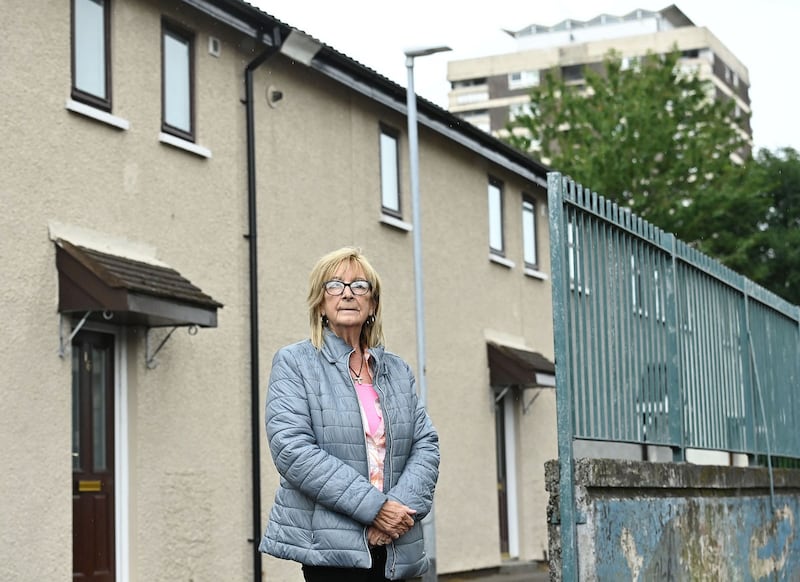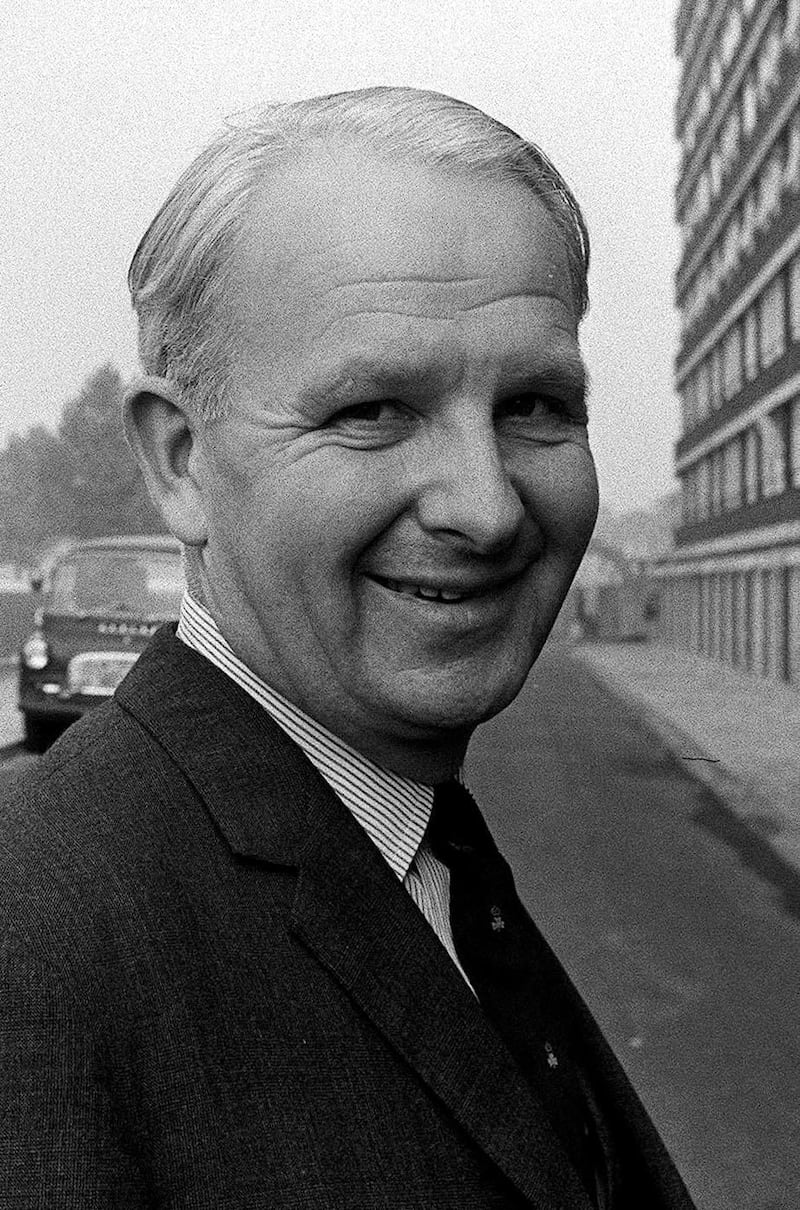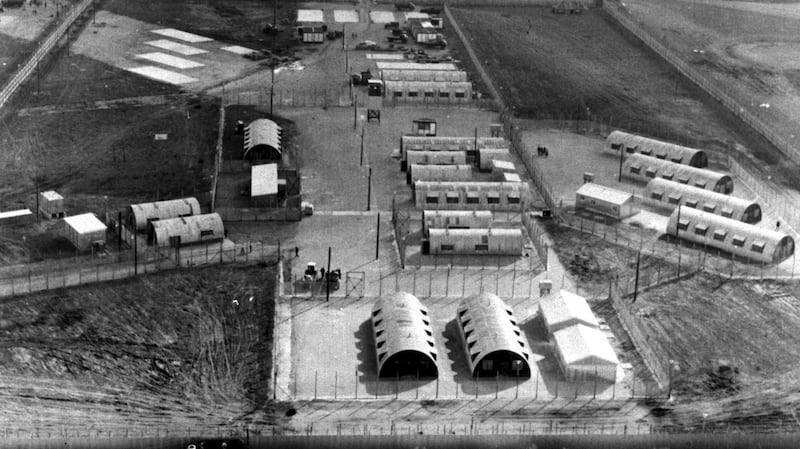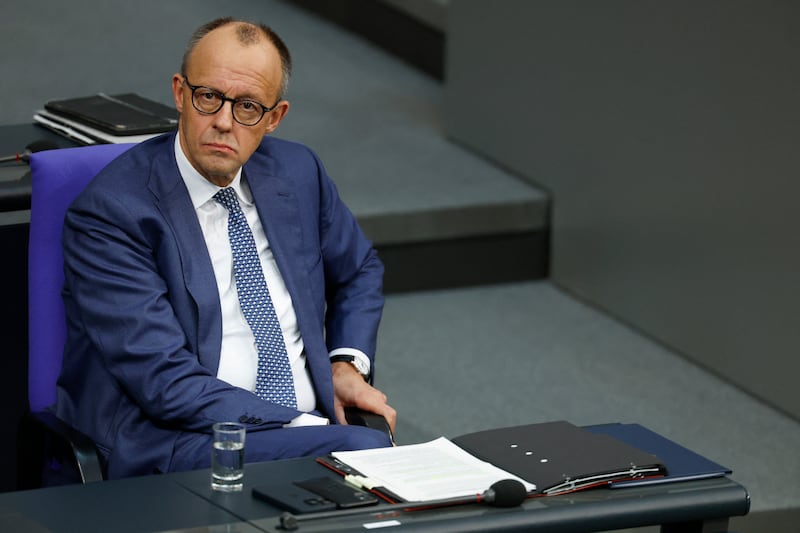When the crash of the door being kicked in woke Michael and Orla Farrell, followed by the pounding of boots on the stairs, he leaped up and flung open the bedroom door. "It's okay, it's only the army," he called back to Orla, as the soldiers piled in around him and began to drag him away. It was around 6am on August 9th, 1971, in south Belfast. Fifty years later, Orla remembers her relief at his words. "We thought someone might have been coming to kill us," she said. Now she knew that it meant something else. Michael was going to prison without trial. This was internment.
It had been expected. The new prime minister for Northern Ireland, Brian Faulkner, was known to be a keen advocate, believing it had been responsible for finishing off the IRA's border campaign in the late 1950s. The draconian Special Powers Act allowed for it. A second World War airforce base at Long Kesh, near Belfast, had been converted into a compound, the old nissen huts surrounded by high barbed-wire fences with guard towers. Against all the evidence, the unionist government persisted in ignoring the real grievances of the nationalist community. It likewise ignored the poverty of a section of the community it claimed to represent, encouraging Protestants to blame Catholics for all their problems.

Having attempted to defeat the civil rights campaign by beating protesters off the streets, which led the British government to send in the army, the Stormont regime now faced a major upsurge in violence involving the IRA, loyalists and the security forces as well as ordinary people who took part in riots and demonstrations. There were bombs; gun battles involving soldiers, republicans and loyalists; and assassinations. Thousands of people were driven out of their homes. Whole streets were burned.
Michael Farrell was the leader of the People’s Democracy (PD) movement, and had organised the march from Belfast to Derry in 1969 that was attacked by loyalists and members of the RUC’s B Specials at Burntollet bridge and again as it reached the city. Both of the Farrells were hit by bricks, and Michael was knocked out. The PDs, while more militant than the Civil Rights Association, were resolutely anti-violence.
On the night of August 8th, 1971, the prospect that internment was imminent was discussed at a PD meeting in Strabane. Back home Orla suggested Michael might be better to get offside. He was tired and said they could talk about it in the morning. Instead he found himself, half-dressed and barefoot, bundled into an army jeep and brought with others to Girdwood army barracks, where they were lined up in a hall with over 100 others.
'I got wakened at 3.30 in the morning by a blow to my stomach from a rifle'
“Soldiers would come in and randomly pick people and march them out,” he says. “I remember saying to someone, ‘This is fascism.’ We knew the British army had done this kind of thing in Kenya and Cyprus. I wondered if there had been a coup and the army had taken over.”

His turn came. “We were brought outside and told to run across this area which was strewn with rubble and broken glass. The soldiers were beating us, and they set dogs on us. I was made to stand in a box and told to sing God Save the Queen. I said, ‘I can’t sing.’ You could hear gunfire and it was dark. I thought there was a good chance I would be taken out and shot.”
Francis McGuigan was one of 14 men lifted on August 9th who were brought to that same barracks and then disappeared. “I got wakened at 3.30 in the morning by a blow to my stomach from a rifle,” he says. He was hooded and put into a helicopter. It took off and then slowed down.
“I was gripped and thrown out backwards. I had no idea how high up we were. Then I was caught by soldiers. I had heard of this being done in Vietnam. Then I was brought somewhere else and put in a boiler suit.
“I am from a republican family. When I was 14, I remember getting lifted out of bed by the police and questioned about who was visiting our house. My parents were both interned over the years, and at one stage six members of my family were in prison at the same time.”
He was forced to lean forward with his fingertips spread out on a wall, legs spread-eagled and then had his back pushed in to make a bow shape. When he collapsed and curled in a ball, he was kicked and forced back into position. He was not allowed to sleep. He was refused access to a toilet and had to relieve himself in the boiler suit. There were interrogations for which he was handcuffed. Soldiers shouted into his face so that he was covered in their spit and could not wipe it off. He was dragged about by his hair until his feet were raw. But the worst was the place called “the music room”, where he was subjected to white noise. “After I became aware of it, I felt that it came in through my hair, travelled down through my body, came out my feet and then came back in again. It was in every nerve of my body.” He came in and out of consciousness. He hallucinated that friends came but refused to help.
“After a while I thought, They aren’t letting us out of here alive. They couldn’t afford to let us tell the world,” he says. But after what turned out to have been a week, he was brought by helicopter to Crumlin Road. “There was a man beside me, and I looked and thought, that poor soul, what has he been through? That was Seán McKenna. We all had a blank stare on our faces.” McKenna’s hair had turned white. He had been a civil rights activist. It would later emerge that the men had been taken to a special unit in Ballykelly in Co Derry. Their internment papers had been personally signed by Faulkner. Some were republicans, others were not.

McGuigan was interned in Long Kesh until he escaped in 1972. “It was the Sunday after Bloody Sunday, which we had heard about on the radio,” he says. The Derry internees had been elated about the march, which was in protest at internment. “When the news of the deaths started to come in, they were like zombies,” says McGuigan. “They thought it might be their families.” With the agreement of the escape committee, wearing black clothes and a spare dog collar and with a set of car keys supplied by a priest, McGuigan made off. He could not work out how to reverse the car, but a soldier who wanted a lift did it for him, handing him his rifle as he did so.
“I’m not your usual suspect,” says John Carlin. “My father was a British soldier who served in the second World War and was in Aden and Cyprus and all the colonised spots. He died when I was 13 and we came back with my mother to Derry, where I began to listen to republicans.”
He left school with no secondary education and went to seek work in London in the 1960s. “I got involved in trade unionism in London, came back to Derry for the riots in 1970. I got involved in republicanism but I was always more drawn to the political side of things. I liked the old liberal tradition that came before partition institutionalised sectarianism.”

His experience of internment was brutal, and included “a brush shaft up my backside, and cigarettes on my eyelids”. As far as he was concerned, “the more they interned, the more got involved. It just made people more political”. He got an education in the cages of Long Kesh. “I did Irish classes and history classes and I came out and did a politics and history degree.”
'I saw myself as a left committed person and not as a nationalist. There was a terrible innocence too'
The republican tradition in Seamus Keenan's family goes back generations. "My grandfather was in the IRA in the 1920s and got interned. My father was involved and interned in the 1940s and again from the 1950s into the 1960s. My mother was interned during the second World War. She was very left-wing – she talked about Algeria and Fidel Castro – but she was also a daily communicant. She wanted me to have an academic career. I was at Trinity College in Dublin in 1969. I thought I was very radical. I was more interested in what was happening in France than in Ireland. When internment came, my father was lifted – as usual. He was held on the prison ship Maidstone and then in the Kesh."
“I came back to Derry and was active in the republican movement. It was unbelievable what was happening, from the Battle of the Bogside in 1969 to the riots and internment and then Bloody Sunday – I was at the march.” One of his brothers, Sean, who was in the IRA, was shot dead by the army in the street that year. “I saw myself as a left committed person and not as a nationalist. There was a terrible innocence too. People were getting involved and they had all the slogans – the 32-county democratic socialist republic and all that. I thought the IRA would deliver that,” he says, and laughs. “You learn. To a 17-year-old it was romantic.”
The sounds of gunfire Michael Farrell heard from Girdwood that August night might have emanated from Ballymurphy. Carmel Laverty waseight in 1971, the youngest in a family of 11, and living in the west Belfast estate. She and some of her siblings had already spent several weeks as refugees at Gormanston in Co Dublin. She remembers the tension back in Belfast.
“Everyone was listening to the radio all the time. The women were doing duck patrols – they walked around the estate to make sure the army wouldn’t lift or shoot the young lads. On August 9th there was a curfew and the army moved in. People were getting shot. On the 10th our John, who was 20, came and told my mother the men were evacuating women and children. He brought me and two of my sisters to the pick-up point at the community centre. After we got in the van he stood in the road waving, and I waved back until I couldn’t see him any more.”
That was the last time she saw her brother. That night, despite their mother camping at the bottom of the stairs to try and keep her sons at home, once the bin lids started rattling, John and Terry insisted on going out. Women would bang the metal bins on the footpaths to signal the army was on the move. Gun battles meant people were largely confined to their homes. The family heard nothing for two days, until a neighbour who had been to the morgue came to the door. John had been shot dead, one of 10 fatalities in what became known as the Ballymurphy massacre. Fewer than 100 people had been killed in the Troubles before internment – by the end of 1971, a further 150 were added to the toll.
Carmel and her sisters went to a refugee camp in Kildare.
Marian Friel was not interned in the first wave. It was in 1973, after what became the worst year of the conflict. In 1972 almost 500 people were killed. It was the year when the British army carried out Bloody Sunday in Derry and the IRA carried out Bloody Friday in Belfast.
Friel, who was 19, was just getting on with her life. “I had a great job as a packer at Gallagher’s tobacco factory. I had enough money for myself and to give my mother a wee wage. Then one day I had just got home from work and the army came. They put me in a truck and brought me to a barracks. I was put in a yard and they gave me a lot of abuse, claiming I was looking at the soldiers.”
The abuse was sexual in tone. “I was the only woman around and I began to be afraid,” she says. They held her for three days, repeatedly insisting during interrogations that she was in the IRA. “I wasn’t,” she said. “I had nothing to say.”
She was brought to the women’s jail in Armagh and kept for two years there as an internee. Some of the other women interned were IRA volunteers. She was strip-searched every time she got a visit, which was, she says, “very degrading.” She was keenly aware of the hardships her lost income had created for her family. “Then word came from Merlyn Rees [the Labour government’s secretary of state for Northern Ireland] that I was one of the ones to be released. I didn’t know what to do with my life. Thrown into jail, thrown out of jail. My job was gone and all I could get was wee jobs like cleaning. I was an ex-prisoner.”
Internment was Faulkner’s one big idea to end the Troubles. The heads of both the British army and the the RUC opposed it. Eventually Faulkner flew to London and convinced prime minister Edward Heath that it was the only option and that he had all the right names on a list.
Faulkner’s deputy at the ministry of home affairs was John Taylor, now Lord Kilclooney, who says the first he knew about it was when, returning from holidays in France, he was being driven from Dublin Airport to Armagh. “When driving past Newry I became aware of unrest and the banging of bin lids. I asked the police what was going on. To which they replied, to my surprise, did I not know that internment had been introduced overnight.”
The IRA had read the signs, and most of its members were no longer staying at home. Of the 342 men arrested in the first swoop, 116 were released within 48 hours, and many others had no IRA connections whatsoever. Michael Farrell has obtained a “top secret” document sent between British officials that shows the RUC had suggested that members of PD and others should be included since they posed a “special threat” by “fomenting violence”. The document also explains why only Catholics were to be lifted. “Objectionable Protestants,” it said, were not organised and in any case the security forces would be too busy to deal with further trouble. Naturally, the exclusion of loyalist paramilitaries further antagonised nationalists.
Orla Farrell and Judith McGuffin, whose husband, John, had also been lifted, got organised immediately, calling those members of PD who had phones to alert them to what was happening, holding media briefings, meeting with the Association for Legal Justice and visiting the prisoners. (Judith McGuffin also persuaded the prison authorities that her husband required fresh fruit, and began delivering grapefruit injected with vodka to him.)
Two priests, Raymond Murray and Denis Faul, began compiling statements from internees. John McGuffin went on to write a book about internment, published in 1973. Judith McGuffin says internment changed his politics. “He started out an anarchist; he got more republican-minded,” she says.
John Gray, who had left Northern Ireland with his wife, despairing of its politics, was in London when he heard that internment had begun. He quit his job and set up the Anti-Internment League, which attracted 50,000 people to one of its demonstrations.
'I have nightmares and panic attacks and I’m heart afraid'
Gray returned to Belfast and for many years ran the Linenhall Library. The various campaigns drew international attention to what was happening in Northern Ireland. The British government, embarrassed and exasperated as Faulkner continued to insist he had been right, dissolved Stormont.
Several of the hooded men died prematurely. Seán McKenna did not recover. He had a series of heart attacks, the last of which killed him in 1975. His son, also called Seán, was interned with him because the soldiers did not know which one they were meant to take.
After being released from prison, he became involved in the IRA. After surviving prison terms, the dirty protest and a hunger strike, he died by suicide in 2008.
“Sometimes you still get plunged back into it,” says McGuigan. “I have nightmares and panic attacks and I’m heart afraid.” The surviving hooded men gave evidence to the European Court of Human Rights that found they had suffered “inhumane and degrading treatment”. McGuigan says they will continue to campaign until Britain is found guilty of torture. They are awaiting a supreme court ruling.
'It turned the movement for civil rights into a sectarian thing. It pushed people back to the ghetto'
Seamus Keenan says that “a lot has changed for the good” in the North. However, he adds, “Derry is still neglected. People are still poor in the Bogside, Brandywell and Creggan. There is still something poisonous in the six counties.”
Carmel Laverty’s daughter, Mary Kate, joined the campaign for justice for the Ballymurphy families, and now works for the Relatives for Justice group. In May, after an inquest lasting 100 days, Ms Justice Siobhán Keegan found that John Laverty and the rest of those killed in the Ballymurphy massacre were “entirely innocent”.
Internment ended in 1975, by which time almost 2,000 nationalists and 107 loyalists had been jailed under its provisions. Apart from the lives taken and ravaged, Michael Farrell says its political legacy was one of irrevocable damage. “It turned the movement for civil rights into a sectarian thing. It pushed people back to the ghetto. The IRA got more and more involved, and the national question became the central one rather than human rights and equality. Step by step, any hope of changing things through political means was crushed.” Farrell has had a career as one of Ireland’s leading human rights lawyers, and is a member of President Michael D Higgins’s Council of State.
Marian Friel has had a difficult life, marked by long periods of depression. “I asked myself, Why really did I have to go through all that?” She has never been given an answer.

















